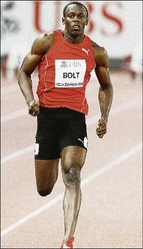Running like 'Lightning' Bolt
Published: Wednesday | September 9, 2009

Kenneth Gardner, Fitness Club
All of our muscles are not entirely the same. They have a mixture of white and red or fast-twitch and slow-twitch fibres. Muscle cells or fibres that contract or twitch fast are called fast twitch, and those that contract slowly are called slow twitch.
Fast-twitch muscle fibres are especially adapted to short, explosive contraction. A biopsy of the muscles that extend and flex Usain Bolt's knees and hips is the ideal test to confirm his muscle make-up. Chances are his fast-twitch, slow-twitch ratio would be exceptional when compared to other athletes.
Usain's muscles
No one has been identified with a muscle structure that is 100 per cent fast twitch or 100 per cent slow twitch. Usain's combination could be the closest to being all fast twitch. Muscle fibres have a wide range of characteristics that are associated with their rate of contraction or being fast twitch or slow twitch. The structures within the muscle cells or fibres are fundamental to the way they function. There are specific chemicals, such as enzymes that stimulate the actions that influence contraction. The ability of the muscles to produce energy is important to the movement displayed when muscles contract.
The blood vessels in terms of the capillary network of fast-twitch muscle fibres are different to those of slow-twitch fibres. Capillaries are much more pronounced in slow-twitch muscle fibres, especially after extensive endurance training. Probably the most important characteristic of the fast-twitch muscle fibre is their nerves. Those nerves have a special sheath that covers them and facilitates the fast transmission of nerve impulses and thus, the fast rate of their contraction. Fast-twitch muscle fibres are bigger than the slow-twitch fibres. Speed and power activities will develop the rate of contraction of the muscle fibres.
Nerve impulses
The most fundamental factor underlying the rate of movement is caused by nerve function. Without the electrical activities of the nerves, the muscle is deemed paralysed. Paralysis is simply a case of the muscle fibres being deprived of nerve impulses or electricity.
Exercises that involve speed and power train the nerves to emit impulses faster. The faster nerve impulses are transmitted to muscle fibres, the faster one is able to run as the muscles contract. Nerve fibres differ. Some of them have a special sheath that cover them. Fast-twitch muscle fibres that are stimulated by nerves with the special covering transmit impulses much faster. Thus, they make those fast-twitch muscle fibres contract even faster, and those people run much faster.
The chemical activities that occur in fast-twitch muscle fibres are also significant characteristics. Fast-twitch muscle fibres have special enzymes that effect unique chemical actions, such as the way energy is produced to carry out the muscles' actions.
Running is also a mechanical action, so when you have long legs or levers such as Usain's, and the right biochemical activities, the right combination could make you lightning fast.
Dr Kenneth Gardner is an exercise physiologist at Holiday Hills Research Center; email: yourhealth@gleanerjm.com.

Jamaican Usain Bolt runs to win the men's 100 metre race at the Weltklasse Golden League athletics meeting in the Letzigrund stadium in Zurich, Switzerland, recently.


